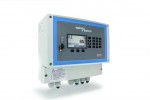Correct sizing
Published: 10 September, 2014
Correct sizing of pipework and valves for steam applications ensures reliable and efficient operation. Ian Webster, hygienic processing segment manager at Bürkert UK looks at some of the basic calculations that should be understood by design and maintenance engineers in order to achieve a safe and efficient process.
Steam is used in a wide range of industries for a variety of processes, from a basic small heating circuit to large-scale hygienic steam production, involving specialist equipment, which needs to be designed and maintained properly to ensure efficient and reliable operation of the process equipment.
Modern production environments require the maintenance team to be experts in a vast range of fields and while many areas may be adequately covered, steam equipment can sometimes be overlooked. This can lead to costly breakdowns or repairs which could have been avoided if some basic principles were better understood.
Initially, it is important to understand a few basic principles, such as pressure measurement, which in the main, is quoted as gauge pressure, which reads zero at ambient air pressure and would be displayed as 3 bar(g) for example.
Most steam process designs use a recommended steam velocity of 25m/sec when designing the system and unless specifically required otherwise, this speed should be used when making steam calculations. The maximum velocity is 40m/sec (over 140 kph), however as a general rule of thumb, pipe and valve sizes are usually calculated using 25m/sec as the reference speed.
This forms a crucial part of the design as oversizing pipework can lead to unnecessary materials costs, increased installation costs including support structures and insulation. Larger pipework also leads to increased condensate levels due to greater heat loss, which in turn will mean additional steam trapping is required or wet steam reaching the point of use resulting in reduced operational effectiveness.
On the other hand, undersized pipework will result in a reduced pressure at the point of use, which may impede the performance of the equipment requiring the steam energy. The reduced size of the pipework will also increase the velocity of the steam which can cause water hammer and increased erosion levels.
The Safety Valve is designed to protect the boiler shell from over-pressurisation and explosion and so sizing of the Safety Valve is a crucial process in order to ensure the proper safety levels are maintained. The Safety Valve must be able to pass the maximum possible flow rate in the event of a Pressure Relief Valve (PRV) failure, a point that can be overlooked in some cases.
Due to the complex nature of the mathematical equations used in calculating pipe sizes, a number of tables have been produced to provide assistance in selecting the correct pipework. In order to use these tables it is essential to have accurate information relating to the system design, such as the flow rate of steam required by the equipment as well as the operational pressure of the steam. Based on this information, the nominal pipe diameter can be calculated.
In a similar way, charts are produced by the manufacturers of steam equipment such as steam traps, which allows calculations to be made to ensure the correct size is installed. Again, the basic design information required is the flow rate as well as the supply pressure and discharge pressure. By calculating the differential pressure and finding a suitable flow rate in the manufacturers chart, the appropriate trap size can be evaluated from the table.
As a general rule, when installing a drain pocket, it should be of the same pipe diameter as the steam main, up to a size of DN100. In addition, the pocket depth should be a minimum of 100mm from the bottom of the steam main. If a smaller bore drain pipe is fitted then the velocity of the condensate will allow it to skip over the drain pipe connection. In addition, the reduced volume of the drain pipe may cause it to overflow, thereby becoming another source of water hammer.
Further work is required to calculate the size of the condensate pipework, which poses a different challenge, namely the handling of flash steam. As a percentage by volume, flash steam can make up between 95 and 99% of the total volume in the condensate pipework. This leads to the steam being considered as the defining parameter when calculating the size of the condensate pipework.
When it comes to ensuring the correct control valves are specified for a project, the number of variables is greatly increased and it may be advisable to seek expert assistance from a manufacturer.
Provided the basic design information is available, then a sizing tool can be used to calculate valve sizes, orifice diameters as well as issue warnings about possible cavitation, flashing and choked flow, all of which can lead to damage to other equipment as well as the valve itself.
For further information please visit: www.burkert.co.uk





 With the launch of the its B850 Flow Computer, SPIRAX SARCO says steam system operators can now accurately measure true boiler efficiency without the need for Building Management or Supervisory Control and Data Acquisition (SCADA) systems that can be costly and time consuming to implement.
With the launch of the its B850 Flow Computer, SPIRAX SARCO says steam system operators can now accurately measure true boiler efficiency without the need for Building Management or Supervisory Control and Data Acquisition (SCADA) systems that can be costly and time consuming to implement.
